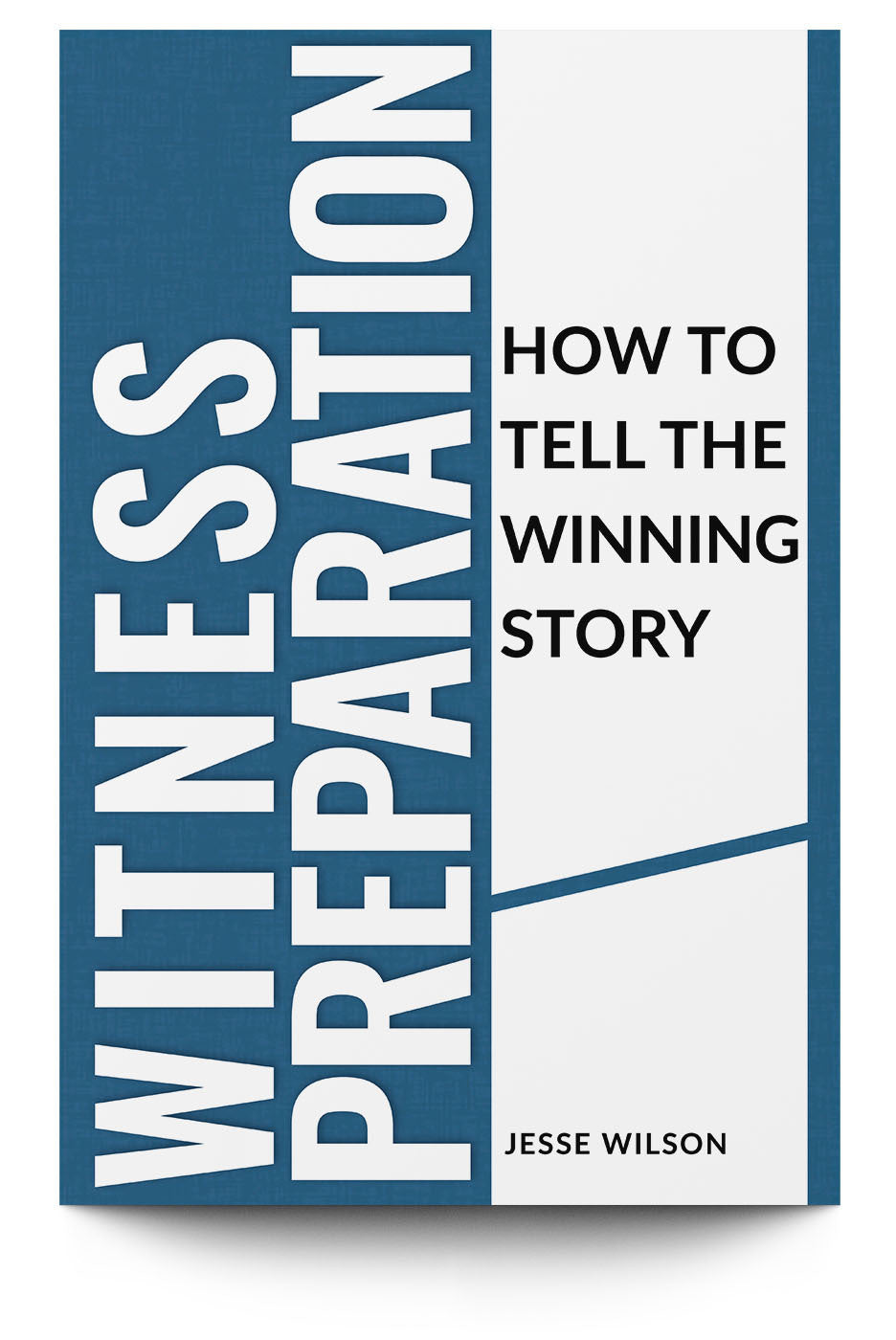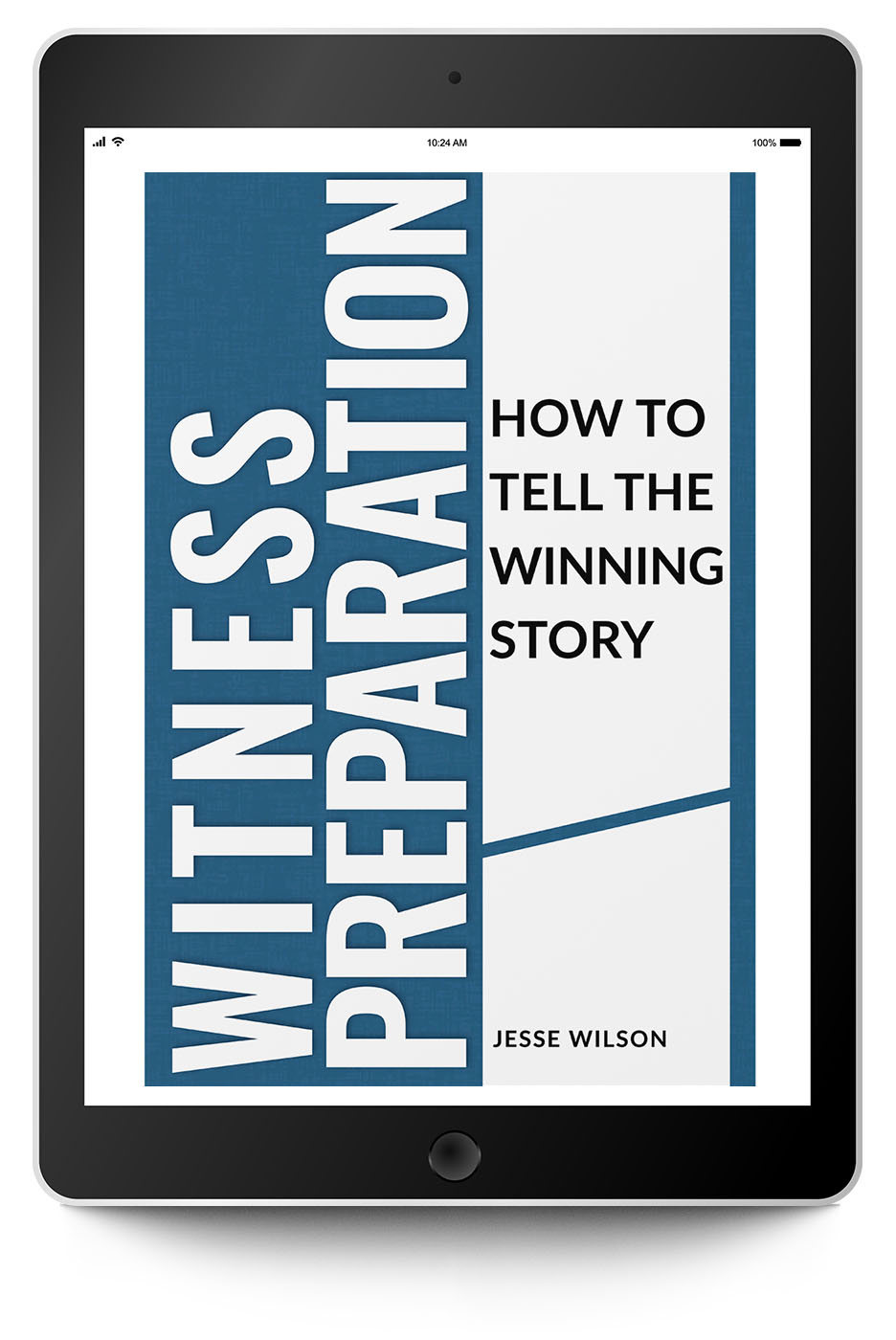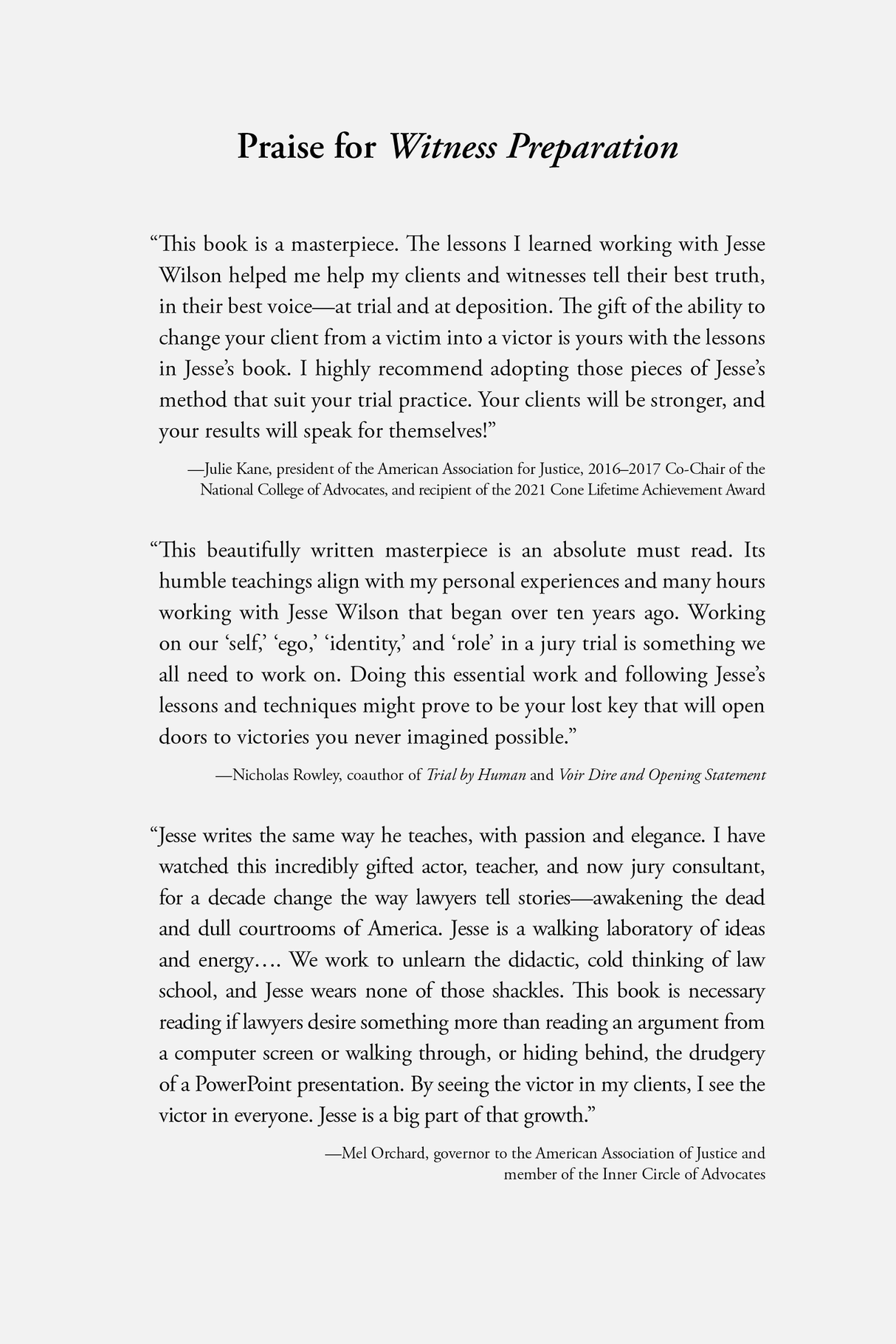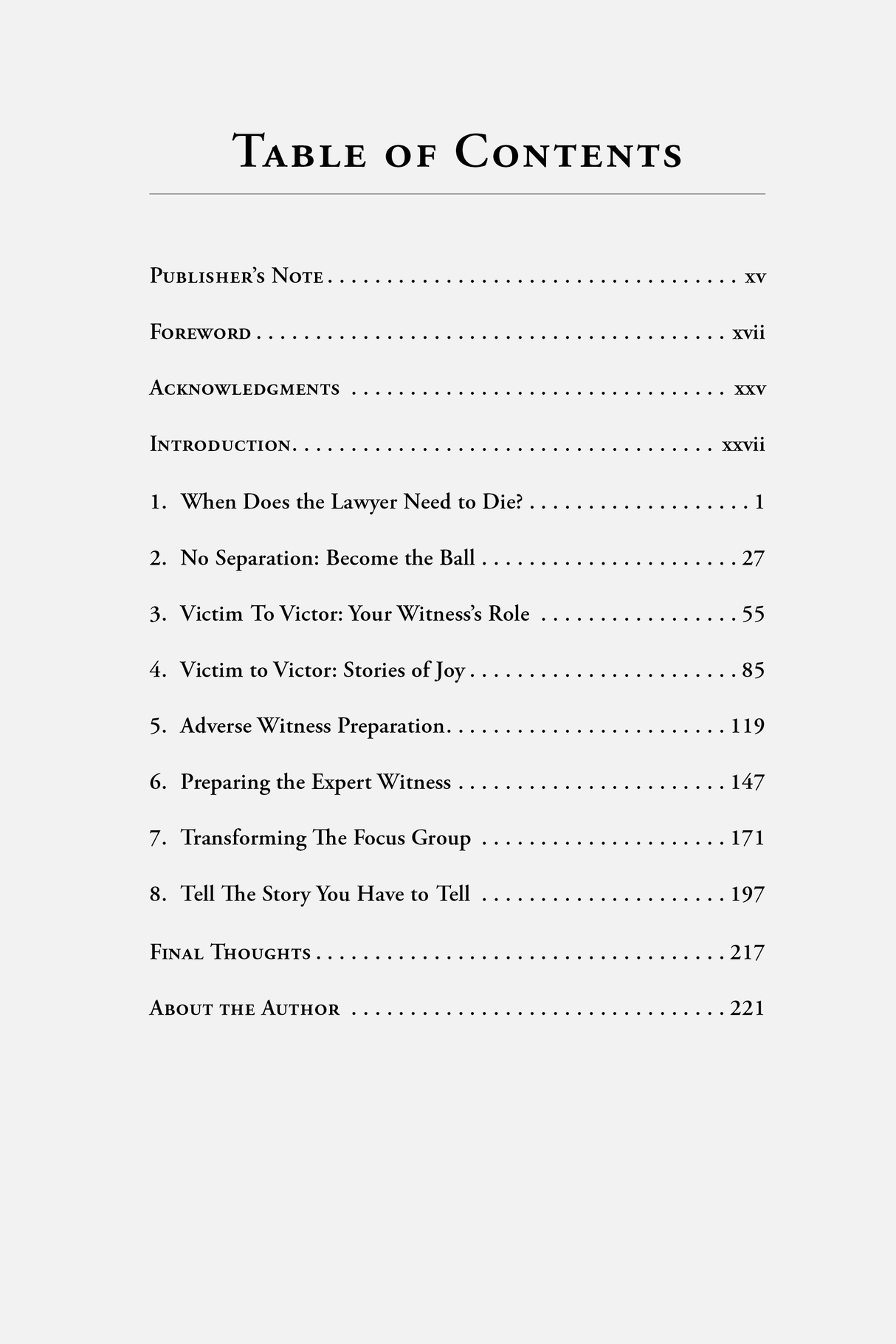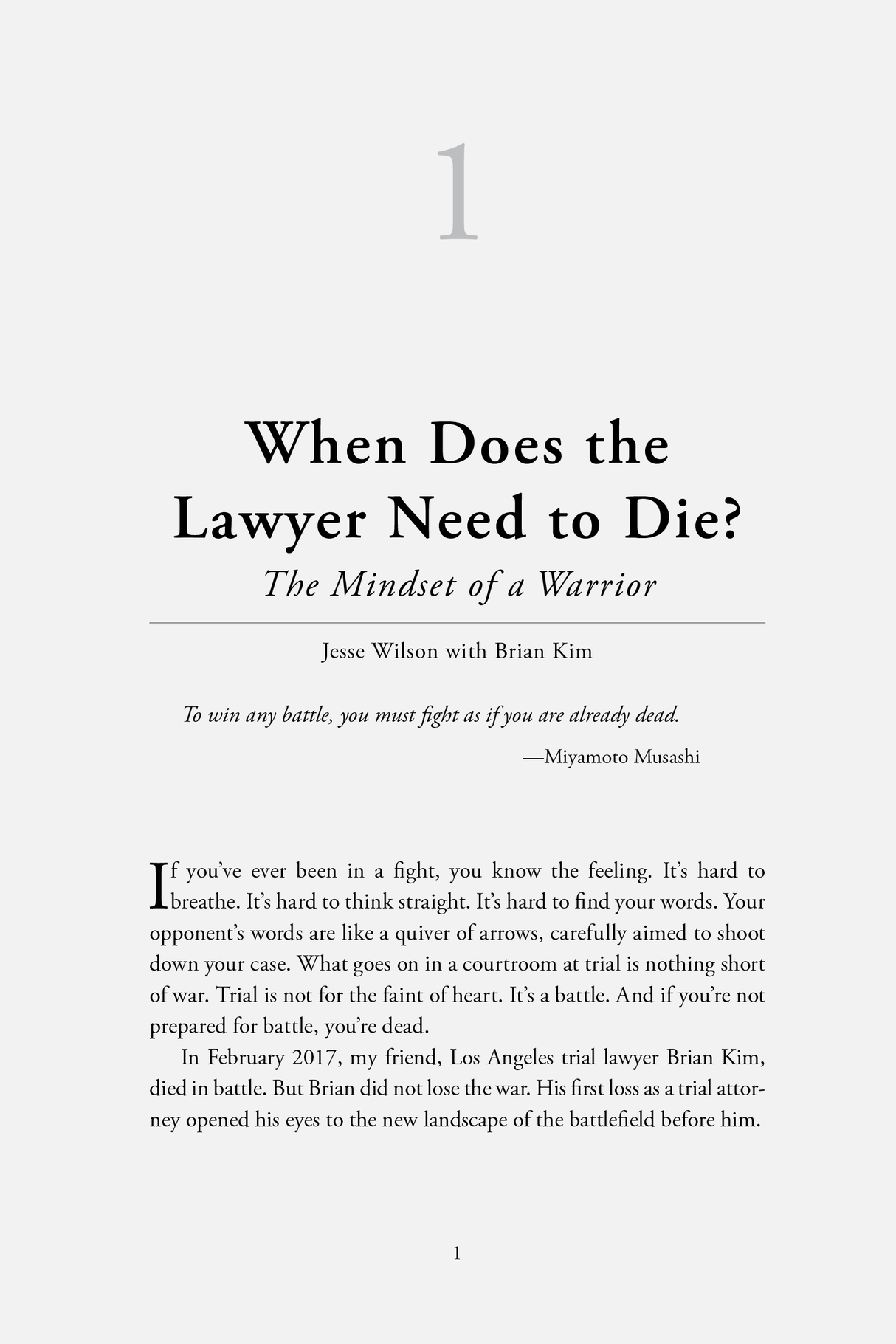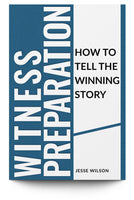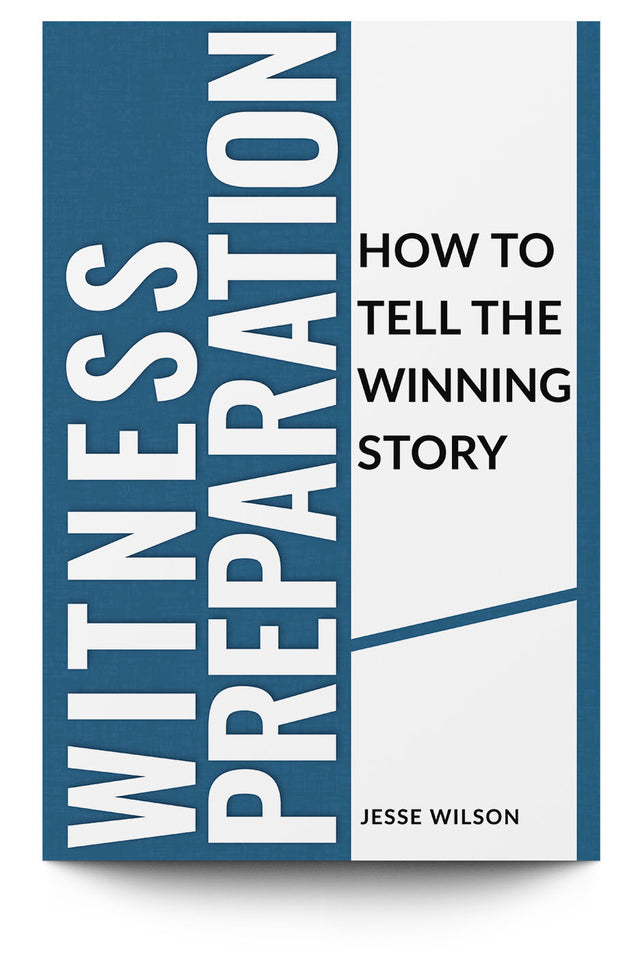Description
Description
“If you want ordinary results, don’t read this book. If you want to learn how to cast your client such that their compelling voice and spirit shines through, [so] that others root for them, protect them, and even fight for them, read this book now. This book will shift your thoughts about what the most compelling damages story is, and it gives you practical pointers to put these new ideas in action right away in your cases—for trial and even for pretrial settlement.”
—Joe Fried, co-founder of the Academy of Truck Accident Attorneys and trial attorney with $1 billion in recoveries
How do you see your witness? How will the jury see them? The judge? The defense? The more compelling—the more credible—your witnesses are, the more you increase your chances of obtaining a just outcome for your client.
In Witness Preparation: How to Tell the Winning Story, trial consultant and strategist Jesse Wilson teaches you how to prepare your clients, experts, and lay witnesses to deliver effective testimony during both deposition and trial. Wilson has spent years helping trial lawyers and their clients discover, develop, and deliver winning testimony in trial—often resulting in multimillion-dollar verdicts.
Wilson draws from his experiences working alongside trial teams in wrongful death cases, trucking cases, criminal cases, civil cases, and numerous brain injury cases to provide checklists, actionable steps you can immediately take, insightful case studies, trial transcripts, and more, to help you bring out the best testimony from your witnesses. He also introduces you to witness-preparation and case-framing tips from the trial lawyers across the country that he has worked with over the years.
Wilson shows you how to work with your witnesses to present the right story in trial and deposition, one that inspires jurors to action through effective testimony that helps them understand the harms your client has suffered. Throughout the book, Wilson uses what he refers to as the “victim to victor” approach to empower your clients, improve your damages arguments, and present the truth of the consequences your clients are living with—and fighting to overcome—to galvanize jurors to action.
Wilson explains that clients are often mischaracterized when they are solely framed in terms of what was taken from them. When your trial story only focuses on the pain, you risk diminishing your client or making jurors feel manipulated. But a trial story that is framed around joy in the defiance of pain—and the strength it takes to strive to overcome the harm the defendant caused—empowers jurors to act. Referencing the work of Moe Levine, Wilson quotes that “it’s not what they took, it’s what they left behind.” The victim-to-victor approach focuses on showing that what they left behind is the strength of overcoming what has been taken. When it comes to the witness, this should be the lawyer’s primary focus.
Wilson argues (and has the record to prove it) that jurors care more when they see fighters up there on the stand. Somebody they can get behind and help, long after the trial is over. When lawyers go with the tactic of “the poor client, their life is ruined, give them money” jurors end up feeling manipulated. Wilson shows that you shouldn’t care about that story. If you show the fight in your clients, their fight becomes the jurors’ fight.
Wilson teaches how you can develop and deliver a great story of systematic, willful misconduct, a story of serious life-altering injuries, and a story of hope, redemption, and joy. And in the courtroom, Wilson points out that joy is impossible to defend against. As he puts it, “Imagine the defense attorney saying to the judge, ‘Your honor! Mr. Smith is inspiring the jurors too much!’ Or better yet, ‘Your honor! Mr. Smith is allowing his client to inspire the jurors too much!’ That would be a gift, wouldn’t it?”
In this book, you’ll learn a new focus and new action pattern; you’ll be able to frame your case and present your client’s story (and your villain’s story as you’ll learn about in the chapter on preparing for adverse witnesses) in the right way.
Wilson also demonstrates how the victor story can be used to show the defense for who they most often are: the person (or company) who knows the most and cares the least. He provides tools to show the jury how the person (or company) who had the most power to prevent the harm from happening didn’t care in the least that it actually happened.
Later in the book, Wilson also discusses how you can guide your expert witness to give their testimony in the form of a story that the listener feels connected to. Your expert needs to draw the listener into that story. Wilson shows you how you can act as a director and help your expert craft a presentation in a way that engages your judge and jurors so that the information the expert gives them will be embraced and internalized.
Most witnesses are rarely certain of who they need to be, for depositions, for pretrial, and for trial. Learn to reveal them as what they really are, and need to be, for the jury: the victor. In this book, you will learn to apply the victim-to-victor approach to framing and presenting the right story to your jurors, as you prepare both your client (and yourself) for trial. The lessons and methods in this book that Wilson offers will grant you transformative tools that you can start using—today—that will improve your practice, empower your juries, and help your clients.
Your eBooks are now accessible from your Trial Guides account! Click here for step by step instructions.
Do you want the eBook and print book? After you complete your purchase of the print book you will receive a coupon code via email to purchase the eBook for $20.
Author
Author
Details
Details
Paperback: 266 pages; 1st edition (2022); ISBN: 978-1-951962-48-7
Publisher: Trial Guides, LLC
Table of Contents
Table of Contents
Publisher’s Note. . . . . . . . . . . . . . . . . . . . . . . . . . . . . . . . . . . .xv
Foreword. . . . . . . . . . . . . . . . . . . . . . . . . . . . . . . . . . . . . . . . .xvii
Acknowledgments . . . . . . . . . . . . . . . . . . . . . . . . . . . . . . . . . xxv
Introduction. . . . . . . . . . . . . . . . . . . . . . . . . . . . . . . . . . . . . xxvii
1. When Does the Lawyer Need to Die?. . . . . . . . . . . . . . . . . . . 1
2. No Separation: Become the Ball. . . . . . . . . . . . . . . . . . . . . . 27
3. Victim To Victor: Your Witness’s Role . . . . . . . . . . . . . . . . . 55
4. Victim to Victor: Stories of Joy. . . . . . . . . . . . . . . . . . . . . . . 85
5. Adverse Witness Preparation. . . . . . . . . . . . . . . . . . . . . . . . 119
6. Preparing the Expert Witness. . . . . . . . . . . . . . . . . . . . . . . 147
7. Transforming The Focus Group . . . . . . . . . . . . . . . . . . . . . 171
8. Tell The Story You Have to Tell . . . . . . . . . . . . . . . . . . . . . 197
Final Thoughts. . . . . . . . . . . . . . . . . . . . . . . . . . . . . . . . . . . .217
About the Author . . . . . . . . . . . . . . . . . . . . . . . . . . . . . . . . .221
Free Chapter Sample
Free Chapter Sample
What Legal Leaders Are Saying
— Patt Ardis, effected the recovery of more than $140,000,000 in the areas of fraud and negligence, coauthor of Risk Management: Computers, Fraud, and Insurance and Bad Lies in BusinessI am a trial attorney with over forty-five years in the courtroom. Jesse Wilson caused me to rethink my trial strategies. This book pushes the reader to think outside of the box—to focus on the positive side of your client; to highlight his or her post-accident victories rather than defeats; to humanize your client—the VICTOR’S STORY. Jesse directs your focus to finding the story and framing it correctly to help you do your best to help your client—the real win for all. He uses concrete examples in explaining his theories; this makes the book highly readable and easily translatable for your specific case.
— Chris Madeksho, nationwide toxic torts trial lawyer and 1st chair in the first post-Covid plaintiff’s verdict ($14 million) in Washington State in 2020Jesse’s book creates a mirror for the trial lawyer to look into and see oneself trying a winning case. What to do, what not to do, and why. [This is] the rare book which lays it out for you in clear, simple terms. The honest, human story wins with Jesse’s tried and true method.
— Andy Young, obtained the highest personal injury truck crash verdict in Ohio and has testified as a truck safety advocate before the Ohio Senate, Ohio House, and US House of RepresentativesJesse Wilson has written a must-read guidebook for witness preparation that is certain to help both veteran and beginner trial attorneys. This book is chock-full of useful tips, nuggets, and meaningful examples, all of which focus on the story of perseverance in the face of insurmountable hardship. Jesse helps the reader understand the practical reality that when your client frowns, they frown alone; but when they smile, the world—and more importantly the jury—will smile with them. I’ve worked with Jesse as a consultant. I’ve seen firsthand the transformative power he brings to the trial story. His methods and teaching helped us with a sizeable jury trial win! Everything Jesse teaches in this book is sure to maximize client results. I wish I had read this book and met Jesse at the beginning of my legal career. If you want to win trials and win them big, then buy this book. It will help you do just that!
— Eric Fong, achieved the largest compensatory damages verdict for one person in Washington State history ($91,000,000), and instructor at Trial Lawyers CollegeWe, as trial lawyers, inherently want to focus on how injured our client is and the bad conduct of the defendant. The way to the jury’s heart includes a message of hope and inspiration. Jesse tackles this conflict and challenges the traditional teachings of the trial lawyer, capturing hope and inspiration’s elusive magic. An evolution in how plaintiffs’ lawyers must frame a case, Witness Preparation: How to Tell the Winning Story includes practical tips and guidance in a missing link to the current model of how we try cases.
— Aaron Broussard, contributing author to Damages Evolving, and Trial by Human staff instructorEver put on a ‘perfect case’ and lost? The reason is usually simple: jurors are not lawyers and we often put on cases that are perfect for lawyers, not people. This book helps trial lawyers and witnesses understand and deliver a story that will move the real people on the jury.
— Rich Newsome, founder of Trial School and is the 2016 recipient of Best Lawyers’ Lawyer of the Year awardJesse Wilson’s new book, Witness Preparation: How to Tell the Winning Story, is a must-read for all lawyers who represent human beings. The book drives home the importance of helping your client find their voice from a place of love and authenticity. Jesse presents methods for preparing a witness—and trial lawyer—to tell the real story of the case that will connect with a jury. I have witnessed first-hand how Jesse uses these methods to prepare clients, and his approaches have powerfully changed the narrative and super-charged my cases. I’ve also watched as Jesse shared these methods during workshops he’s hosted for Trial School, and have seen the transformative effect he has had on many lawyers in many cases. This book is incredibly powerful and well written. It is also guaranteed to make anyone who reads it a better lawyer.
— John Sloan, president of The Trial Lawyers College, tried over 150 cases to a jury verdict, ABOTA member, and on the board of regents of the Academy of Truck Accident Attorneys.I have had the pleasure of working with Jesse Wilson on several occasions. I knew about his effective strategies for storytelling in the courtroom. I knew that he is a fabulous teacher. I knew that he is a great communicator. What I didn’t know is that he has the rare ability to write about what he does and make it so understandable and compelling. This is a book that I will keep nearby and refer to often as I prepare my cases for trial. It is that good. It is the best book I have ever read about telling the story of our client’s case. I recommend it to you all. Thank you, Jesse.
— Minh Nguyen, founder and trial lawyer at Nguyen Lawyers, ALC; Consumer Attorneys Association of Los Angeles 2023 President (2022 President-Elect)This is a higher-level book for young and seasoned trial lawyers who want to elevate their advocacy skills and to prepare clients to testify. So often our clients, and even us experienced trial lawyers, get sucked into the victim’s role and lose sight of what makes a compelling story. Jesse shifts the victim’s paradigm to the victor’s role using words and structure. Jesse has added to the richness of trial advocacy literature to help people win in court.”
— Pete Kestner, chair-elect of the Academy of Truck Accident Attorneys (ATAA), past chair of the AAJ Trucking Litigation GroupJesse has an ability to move clients through the deep, hardened scars of tragedy and, by discovering and sharing their unique stories of joy, bring them into a place of reaching for life again. I highly recommend this book for all folks doing trial work!
— Render Freeman, nominated to faculty of the Trial Lawyers College, Georgia Super LawyerJesse Wilson has a unique gift for helping us discover the story that we need to tell. He doesn’t write the story; he unlocks the story within us. This takes work… work that must be done early in the case and hopefully before your client and key witnesses have been deposed. As a faculty member with The Trial Lawyers College and the American Association for Justice, I have had the privilege of working with, and learning from, Jesse Wilson. I have brought him into several of my cases to help discern my client’s story of victory. Jesse’s new book helps us do this vitally important work in every case—large and small.
— Nicholas Rowley, coauthor of Trial by Human and Voir Dire and Opening StatementThis beautifully written masterpiece is an absolute must read. Its humble teachings align with my personal experiences and many hours working with Jesse Wilson that began over ten years ago. Working on our ‘self,’ ‘ego,’ ‘identity,’ and ‘role’ in a jury trial is something we all need to work on. Doing this essential work and following Jesse’s lessons and techniques might prove to be your lost key that will open doors to victories you never imagined possible.
— Jody Moore, elder abuse advocate with Johnson Moore, recently part of a 3-lawyer team who tried a 10-plaintiff elder abuse case during the pandemic, entirely over Zoom, to an 8-figure verdictJesse Wilson’s Witness Preparation: How to Tell the Winning Story provides valuable insights on how to direct your case. We, as attorneys, are storytellers and our clients and the other witnesses who come to trial are cast in certain roles to bring the story to life. As a trial attorney, this book will help you be intentional about your casting and directing choices. We are responsible for making sure the client is telling their victor story, and not relegated to victim. Done right, the jury feels free, if not compelled, to root for your client to overcome the injuries and obstacles caused by defendants’ choices. Ready to think outside the box? This book will help you do so, and you’ll be a better lawyer with these tools in your toolbox.
— Bill Gilbert, member of the Million Dollar and Multi-Million Dollar Advocates forums and faculty member of the Trial Lawyers CollegeA courtroom is a trial lawyer’s stage. We make a living putting true life drama in action before a public forum of jurors and judges. In Witness Preparation, How to Tell the Winning Story, Jesse Wilson brilliantly braids concepts and technique applied and taught by the greatest trial lawyers of our time with theory and practice from trained theater professors and graduates and his own personal experience with theater, with inmates in prison, and with trial lawyers, to help us understand the importance of connecting with the story and connecting with the client to find and tell the winning story. I have personally used these methods in trial with record-setting results. If the courtroom is your stage, I highly recommend this book.
— David Ball, PhD, trial consultant and author of David Ball on DamagesJesse Wilson does more than provide ways to do things; he also leads lawyers into thinking beyond and deeper than the traditional. This highly trained Juilliard actor has combined his performer's savvy and talent with an extraordinary understanding of human nature—especially jurors—and the early genius of Moe Levine to create this case-changing approach to witness preparation. And his foundational principles enriches almost everything else about our cases.
— Mark Mandell, member of the Inner Circle of Advocates and past president of the Association of Trial Lawyers of AmericaI thoroughly enjoyed reading Jesse Wilson’s well written book, Witness Preparation: How to tell the winning story. I especially admired how Jesse advocates framing our clients as messages that embody hope and inspiration. Jesse’s advice to turn our plaintiff from victim to victor is wise and intuitive at the same time. This book is well worth the read.
— Randi McGinn, author of Changing Laws, Saving Lives and past president of the Inner Circle of AdvocatesJesse Wilson is an incredible storyteller and the acting techniques he teaches are invaluable for trial lawyers. Love the transformational examples of real cases & prisoners he counseled which make the book come to life. Best of all, his heart and caring for his craft, justice & humanity really shines through it all. This book is a “must have” on the shelf of anyone who must ever present a witness at trial. Grateful for this gift to the world of Jesse Wilson & his incredible insights.
— Judith Livingston, president of the Inner Circle of Advocates, fellow of the International Academy of Trial Lawyers, and member of the New York State Trial Lawyers Association board of directorsMore than a guide for lawyers, Witness Preparation: How to Tell the Winning Story is essential reading. Jesse Wilson brilliantly takes the lessons from the theater and reshapes them for the trial lawyer. He does not teach us how to act, and nothing that is contained in the pages of this book tries to convey anything false or untrue. We are never pretending to be someone else, and neither are our clients. Fiction has no place in court and when a witness is acting the jury often knows it. Instead, Jesse Wilson shows us how to identify with and understand what a plaintiff has lost, to make them a better witness and each plaintiff’s lawyer better at presenting the case. The guidance here includes how to see pain from a different point of view. He teaches us to shift our focus. It is never about “you, the trial lawyer,” but enabling one to elevate their understanding of the client, what they endure, and what they continue to fight for. No one who prides herself on being a trial lawyer will read this book without an understanding of why jurors did not identify with certain witnesses and where he or she failed to connect to the jury. Through basic concepts, fascinating examples, and easy-to-follow lessons, this book provides insights so lawyers and plaintiffs can tell winning stories. Jesse Wilson is more than an actor and trial coach: he is a master of the human narrative.
— Mel Orchard, governor to the American Association of Justice and member of the Inner Circle of AdvocatesJesse writes the same way he teaches, with passion and elegance. I have watched this incredibly gifted actor, teacher, and now jury consultant, for a decade change the way lawyers tell stories—awakening the dead and dull courtrooms of America. Jesse is a walking laboratory of ideas and energy.... We work to unlearn the didactic cold thinking of law school. Jesse wears none of those shackles. This book is necessary reading if lawyers desire something more than reading an argument from a computer screen or walking through, or hiding behind, the drudgery of a PowerPoint presentation. By seeing the victor in my clients, I see the victor in everyone. Jesse is a big part of that growth.
— Dorothy Clay Sims, trial attorney and author of Exposing the Deceptive Defense DoctorJesse’s book is a must have for any lawyer who tries cases. This book provides many nuggets under the category of ‘holy crap—how did I not know this?’ I particularly enjoyed the dying before battle references. Because that’s what trial work is—a battle. How wonderful that Jesse provides us with real life stories that are always so much more interesting than statistics and facts. It’s easier to read and understand mistakes other lawyers made, which helps us learn how to avoid them ourselves. This book clearly took a lot of work and great effort, and it shows. As lawyers, we don’t know what we don’t know. Luckily, Jesse is here for us to help us learn. If you read this book in its entirety—you will have the confidence you didn’t know you didn’t have. And that’s the difference between winning and losing.
— Lloyd Bell, member of the Inner Circle of Advocates and a faculty member of both Trial Lawyers University and Trial School in FloridaMuch has been written about the essential connection between storytelling and trial advocacy. But what story? Whose story? Which point of view? The brilliant Jesse Wilson answers these questions with his newest book, Witness Preparation: How to Tell the Winning Story. Jesse combines his classical theater training and background as a professional actor to teach lawyers how to tell winning stories through their clients. This book is for real trial lawyers who are serious about developing their craft of trial advocacy—both those just starting out and those with hundreds of trials under their belts. Jesse teaches his ‘victim to victor’ story structure, an amazingly powerful structure that flips the traditional narrative of the poor, unfortunate victim to that of a powerful hero striving to overcome adversity.
— Joe Fried, America’s Truck Crash Lawyer, cofounder of the Academy of Truck Accident Attorneys and trial attorney with $1 billion in recoveriesIf you want ordinary results, don’t read this book. If you want to learn how to cast your client such that their compelling voice and spirit shines through, [so] that others root for them, protect them, and even fight for them, read this book now. This book will shift your thoughts about what the most compelling damages story is, and it gives you practical pointers to put these new ideas in action right away in your cases—for trial and even for pretrial settlement.
— Adam Malone, president-elect of the Georgia Trial Lawyers Association, past president of Southern Trial Lawyers Association, and fellow of the International Academy of Trial LawyersI have been privileged to study and train under Jesse’s guidance for the last seven years. Every page of this book contains outstanding advice from an incredibly gifted and talented expert in communication and storytelling. You will find practical advice you won’t find anywhere else that will instantly improve your communication skills inside and outside the courtroom. If you want to discover how to get out of your own way, deeply connect with your jurors, and tell the winning story, don’t just read this book—study it, trust it, and master it.
— Vicki Slater, Trial Lawyers College faculty, recipient of the Mississippi Association for Justice Lifetime Achievement Award, and former president of the Mississippi Trial Lawyers AssociationThis book is a must read for trial lawyers. Through thirty years of trying cases and over twenty years of teaching trial advocacy techniques to the plaintiff’s bar, I have been on a quest to figure out how to bring a case to trial in a way that evokes the healing art that justice is meant to be, and I believe that Jesse Wilson has hit on it in Witness Preparation: How to Tell the Winning Story. Jesse’s method is healing for the client, empowering for the advocate, and clarifying for the hearer and trier of fact. I have personally used his methods and I know many of America’s most successful lawyers swear by these methods. May you read this book, and may you find power and courage and justice at the end of each day that you seek it.
— Ken Levinson, founding partner of Levinson and Stefani Injury Lawyers, coauthor of Litigating Major Automobile Injury and Death Cases, and top 100 Super Lawyer in Chicago for 2022If you have an upcoming deposition or trial, take the following actions immediately: close your computer, turn off your phone, and dive into Jesse‘s book. You will be glad you did; and, more importantly, your clients will be grateful. Jesse supplements his wonderful advice with concrete examples from his work consulting with trial lawyers. These teachable examples lift the curtain to reveal how some of our countries most successful trial attorneys obtain justice for their clients. Every trial lawyer should read, use, and refer to Witness Preparation: How to Tell the Winning Story at every stage of preparing their clients’ cases. Like the talented teacher he is, Jesse’s book will guide you to finding the truth of your clients’ cases and motivate the jury to help.

